On a wind-scoured ridge you’ll feel as exposed as a lone juniper clinging to sandstone, which is exactly why planning matters when you camp at Wupatki National Monument. You’ll need to pack deliberately—water, navigation, and shelter—and respect fragile ruins and fragile weather. Below are practical tips for backcountry camping, trail safety, nearby alternatives, and how to arrange ranger-led programs so your visit stays safe and leaves the site intact.
Overview of Wupatki National Monument and Backcountry Rules
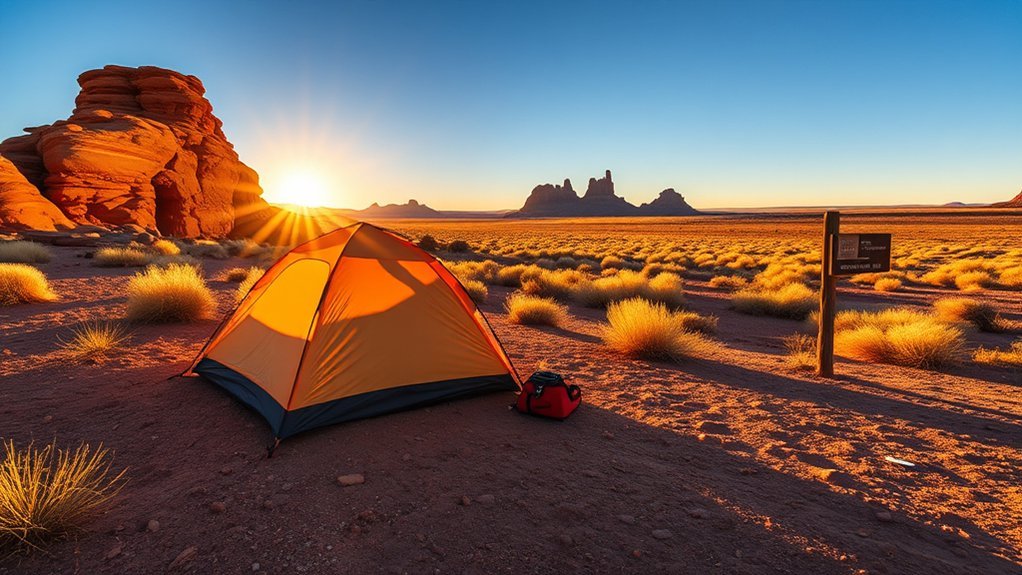
While Wupatki National Monument preserves impressive ancient Pueblo structures and a rugged high-desert landscape, it also requires careful planning for backcountry travel. You’ll find significant archaeological sites and a varied natural landscape, but backcountry hiking here isn’t casual. Routes can be long and strenuous — some require overnight camping — and water sources don’t exist along trails or at campsites, so you must carry ample water. Reservations for overnight hikes use a lottery system; applications go through Recreation.gov and meet posted deadlines. When you camp, follow Leave No Trace principles precisely: pack out all waste, avoid disturbing Pueblo structures, and minimize your footprint. Respect the monument’s cultural resources and prepare thoroughly before you set out.
Preparing for a Backcountry Hike: Gear and Water Requirements
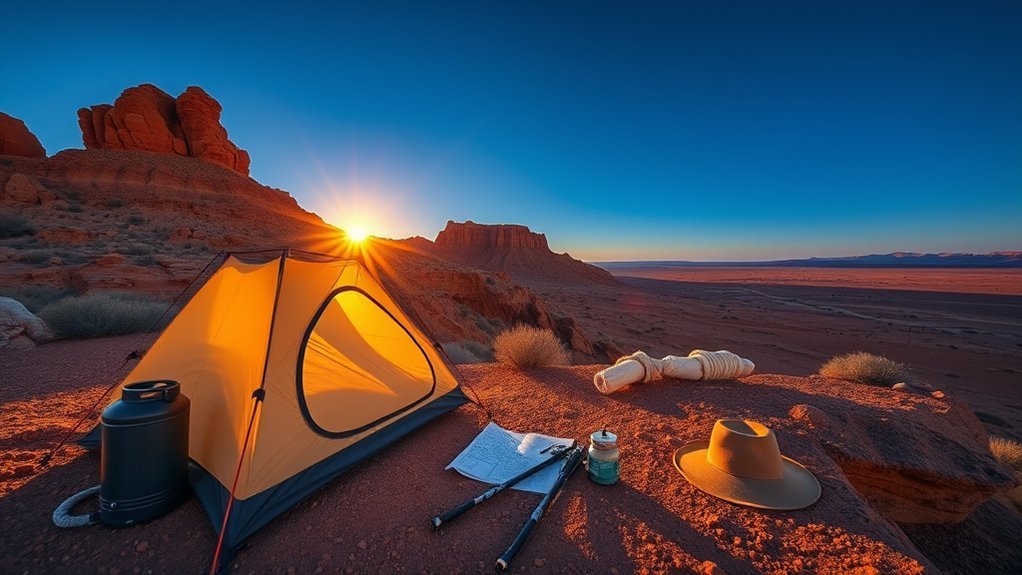
You’ll need a checklist of essential backpacking gear — a sturdy pack loaded to 30–40 pounds, durable boots for cinder and talus, shelter, and a reliable stove and cookware. Plan water carefully: carry at least one gallon per person per day since there’s no water on the route or at camp. Pack all food and extra layers for April’s wide temperature swings so you’re self-sufficient and prepared for changing conditions.
Essential Backpacking Gear
A well-packed 30–40 pound backpack will keep you safe and comfortable on a Wupatki backcountry overnight, so prioritize water, shelter, warmth, and reliable navigation when laying out your kit. Pack essential gear: tent, sleeping system, stove, fuel, food, and at least one gallon of water per person per day. Include navigation tools—map, compass, GPS—and a headlamp with extra batteries. Wear sturdy hiking boots and carry trekking poles to handle cinder, sandstone, and talus. Bring layered clothing for temperatures that can swing from the 20s to the 90s, plus a warm hat and insulating layer. Don’t forget a compact first aid kit and basic repair tools. Organize items for quick access to stay safe during overnight camping.
Water Planning Essentials
After packing shelter, warmth, and navigation, your next priority should be water planning—carry at least one gallon per person per day because there are no reliable sources on the route or at the campsite. On the strenuous hike to Crack in The Rock, plan for 18–20 miles roundtrip and increased hydration needs from extreme temperatures and wind. Bring extra beyond the gallon of water for emergencies and unexpected delays. Stow water centrally for easy access, and balance weight with necessary food and equipment for backcountry camping in a remote wilderness. Scout water sources before you go—there won’t be any—and brief your group on hydration schedules, sipping regularly rather than waiting until you’re thirsty to avoid dehydration.
Food and Stove Choices
Because you’ll be carrying a 30–40 pound pack and won’t find services on the route, prioritize compact, high-energy foods and a lightweight stove that lets you cook quickly without an open fire. Choose dehydrated meals and energy bars as staples; they cut pack weight and deliver calories with minimal prep. Pack nuts, jerky, and instant grains for variety and sustained energy during the backcountry hike. Bring only essential cooking equipment: a canister or liquid-fuel lightweight camping stove, a small pot, spork, and windscreen. Store food securely from wildlife and portion meals to avoid excess pack weight. Since no water sources exist on the route, include reliable water purification or filtration and plan one gallon per person per day when arranging meals and cooking needs.
Trail Conditions, Terrain, and Navigation Tips
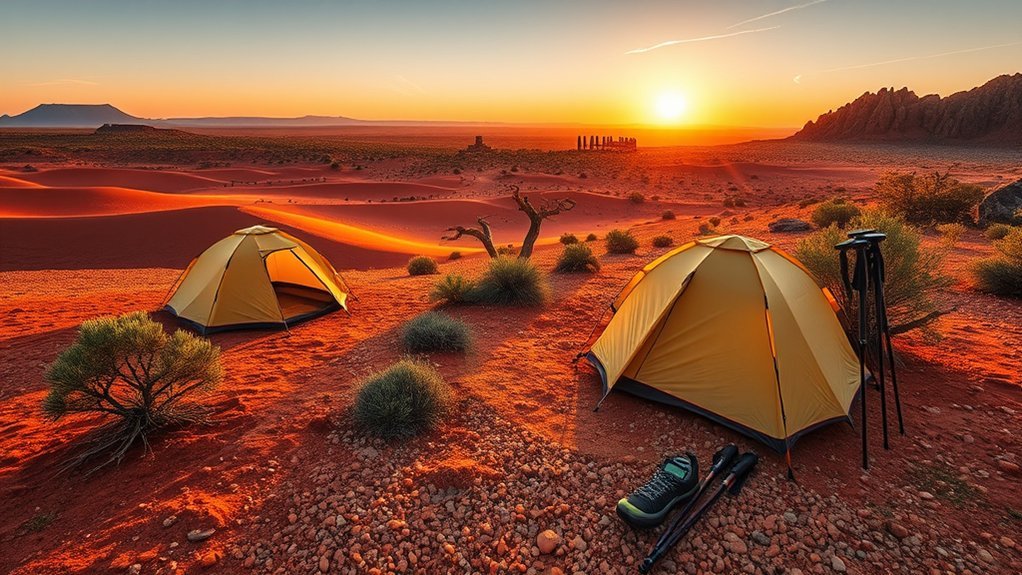
When you tackle the backcountry route to Crack in the Rock Pueblo, expect an 18–20 mile cross-country trek over loose cinder, sandstone, limestone and talus slopes with minimal marked trail, so strong navigation skills and careful footing are essential. Trail conditions are variable; the terrain shifts from stable sandstone to loose scree and talus that punishes missteps, especially under heavy pack weight. There’s minimal elevation gain/loss overall but frequent hilly areas and washes that test balance. You must be self-sufficient: carry all food, gear and water—there are no water sources en route or at the site. Practice map-and-compass or GPS navigation, plan route checkpoints, travel light when possible, and prepare for rapidly changing conditions in April.
Safety Considerations: Weather, Wildlife, and First Aid
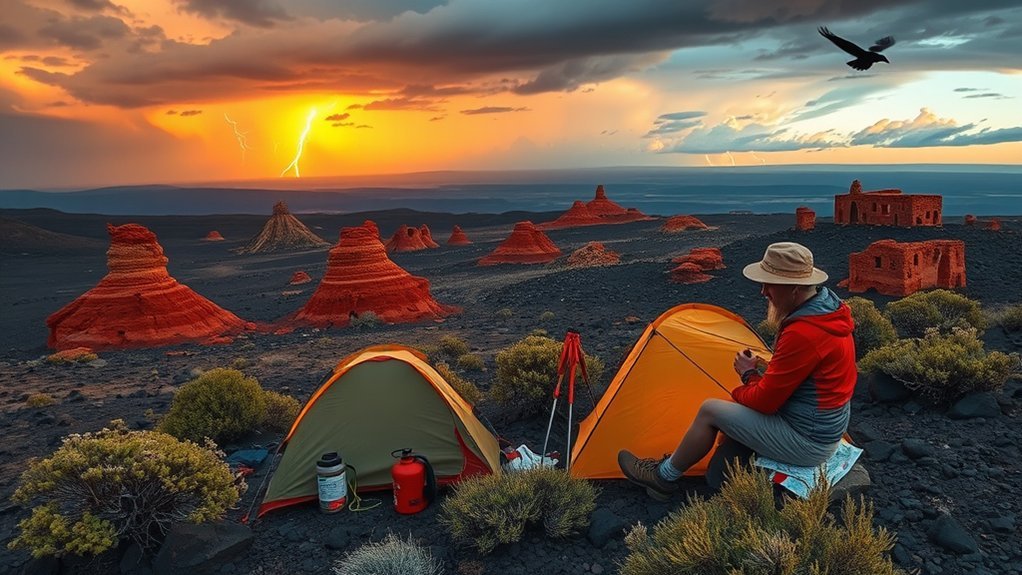
Maneuvering loose cinder and hidden washes is only part of the challenge — you also have to manage the weather, wildlife, and basic medical needs that can turn a long day into an emergency. Check forecasts before hiking; April brings temperature fluctuations from the 20s at night to 90s by day, and wind or sudden rain can affect balance with heavy packs. Carry at least one gallon of water per person per day and plan breaks to avoid heat issues. Be alert for wildlife — rattlesnakes and desert creatures — and avoid close encounters. Learn basic first aid for blisters, heat exhaustion, and common injuries, and pack a compact kit. Take precautions and stay aware for safe backcountry trips.
| Topic | Tip | Reason |
|---|---|---|
| Weather | Layer clothing | Temp fluctuations |
| Wildlife | Keep distance | Prevent encounters |
| First aid | Pack kit | Treat injuries |
Camping Etiquette and Protecting Archaeological Sites
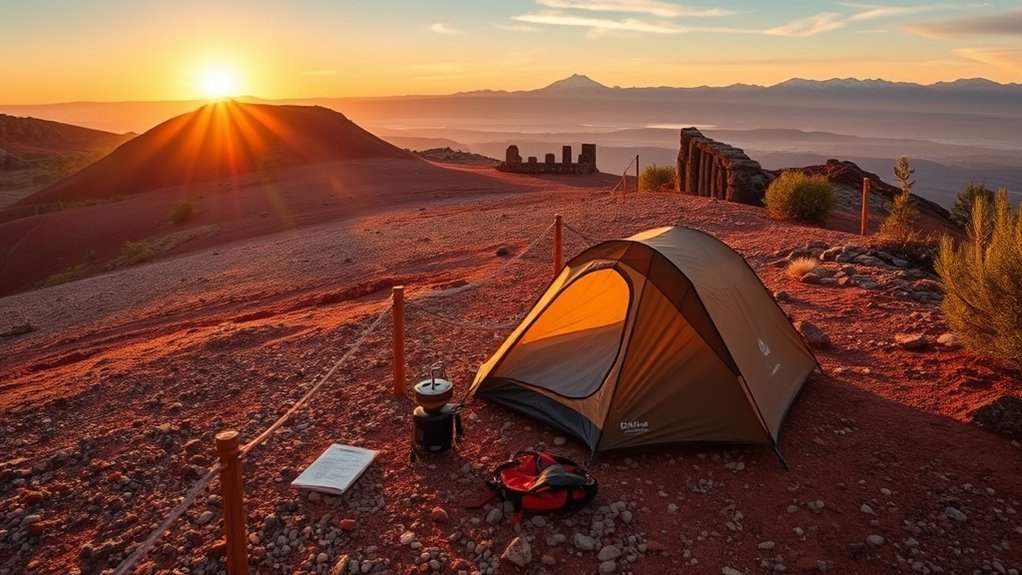
If you want to enjoy Wupatki without harming its irreplaceable ruins, stick to designated trails and established campsites and treat every artifact and structure as fragile. You’ll follow camping etiquette by keeping camps small, avoiding off-trail exploration near archaeological sites, and obeying signs from park rangers. Store all food and waste securely to deter wildlife and protect cultural resources. Practice Leave No Trace: pack out trash and food scraps, leave features as you found them, and minimize campfire impacts. Take advantage of educational opportunities—rangers can explain site significance and historic preservation priorities. Remember the monument’s natural beauty depends on your choices, so act respectfully, report issues to staff, and leave the landscape and ruins intact for future visitors.
- Stay on trails
- Secure food
- Pack out waste
Nearby Campgrounds, RV Parks, and Lodging Options
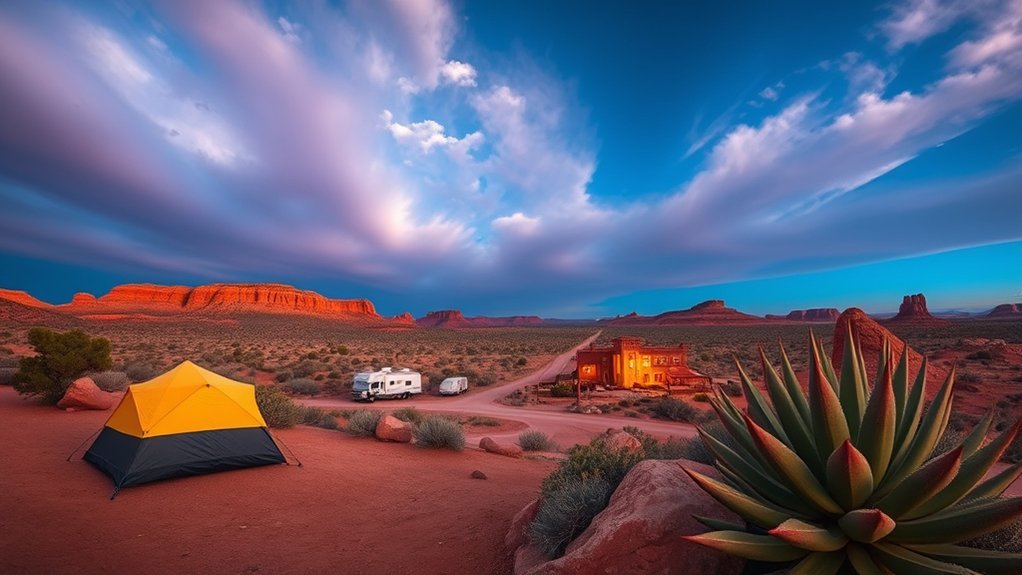
Several nearby options let you tailor your stay around Wupatki—whether you want basic off-grid camping, full-hookup RV comfort, or a cozy cabin after a day of exploring ruins. You can choose Naked Skull Campgrounds for an adults-only, off-grid experience 11 miles from Cameron, with hiking and stargazing across 60 acres and rates from $10. For RV parks and full amenities, Historic Downtown Adjacent RV site in Flagstaff offers full hookups a half mile from downtown. Village Camp Flagstaff supplies adventure cabins and luxury RV sites with full kitchens from $95. Off-grid cabins like The A-Frame By Grand Canyon and Grand Canyon Oasis High Desert Camp (RV and tiny home options) put you within reach of Wupatki National Monument, Grand Canyon access, hiking, and varied lodging options.
Ranger-Guided Hikes, Permits, and How to Apply
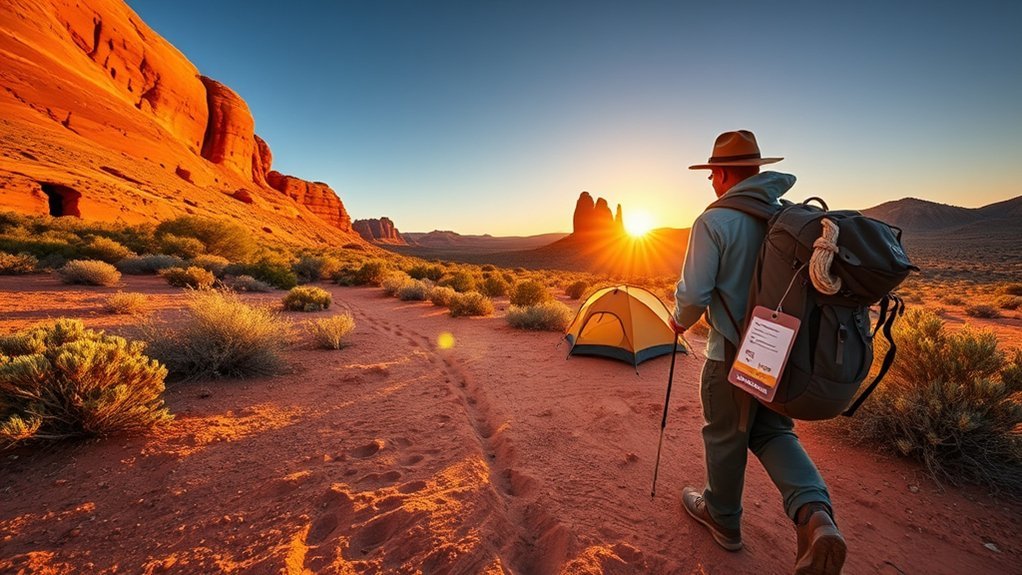
Because these ranger-guided hikes are limited and strenuous, you’ll need to enter the Recreation.gov lottery by the March 14 deadline to be considered for one of the three weekend trips in April (April 8–9, 15–16, and 22–23) that visit the Crack in the Rock Pueblo site. You’ll apply via the lottery system; notifications go out March 17. Expect backcountry hikes over rugged terrain, 18–20 miles with no trails, carrying 30–40 lb packs.
Enter the Recreation.gov lottery by March 14 for limited, strenuous ranger hikes (Apr 8–9, 15–16, 22–23); notifications March 17.
- Prepare: permits are handled through Recreation.gov, participation cost is $75 per person, group sizes cap at 15 (including staff).
- Gear: bring a gallon of water per person per day—there are no water sources.
- Fitness: only well-conditioned hikers should apply; these trips are strenuous.
Frequently Asked Questions
Can You Camp at Wupatki National Monument?
You can’t camp in developed campgrounds; you can join ranger-led backcountry hikes. Follow camping regulations, expect limited campsite amenities, strict fire restrictions, scarce water availability, wildlife encounters, best seasons, hiking trails, visitor centers, photography spots, cultural significance.
How Much Time Do You Need at Wupatki National Monument?
Plan 2–4 hours to see Wupatki history, visitor center, photography spots and geological features; a full day for hiking trails, wildlife viewing, stargazing opportunities, seasonal weather prep, cultural significance, and exploring nearby attractions.
What Is the Difference Between Camping and Backcountry Camping?
You’ll choose between comfort and adventure: camping gives amenities, campsite reservations, fire regulations and camping etiquette; backcountry camping demands backcountry navigation, wilderness safety, camping gear, gear recommendations, environmental impact, seasonal considerations, wildlife encounters.
How Much Is the Entrance Fee to Wupatki National Monument?
The entrance fee is $25 per vehicle; motorcycles pay $20, pedestrians and cyclists $15. You’ll find the fee schedule and payment methods at the visitor center or online; annual pass, fee waivers, group rates, park hours, reservations.
Conclusion
You’ll want to plan carefully before camping at Wupatki—pack a sturdy tent, navigation tools, and at least one gallon of water per person per day, follow Leave No Trace, and camp away from fragile ruins. For example, a weekend hiker I know improvised a dry-camp kitchen, filtered extra water, and kept to established trails, which made the experience safe and respectful. With good prep and caution, you’ll enjoy the monument’s high-desert solitude and ancient sites.

